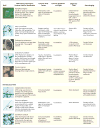Mold infections of the central nervous system
- PMID: 25006721
- PMCID: PMC4840461
- DOI: 10.1056/NEJMra1216008
Mold infections of the central nervous system
Abstract
The recent outbreak of exserohilum rostratum meningitis linked to epidural injections of methylprednisolone acetate has brought renewed attention to mold infections of the central nervous system (CNS). Although uncommon, these infections are often devastating and difficult to treat. This focused review of the epidemiologic aspects, clinical characteristics, and treatment of mold infections of the CNS covers a group of common pathogens: aspergillus, fusarium, and scedosporium species, molds in the order Mucorales, and dematiaceous molds. Infections caused by these pathogen groups have distinctive epidemiologic profiles, clinical manifestations, microbiologic characteristics, and therapeutic implications, all of which clinicians should understand.
Figures


Similar articles
-
Advances in the diagnosis and treatment of fungal infections of the CNS.Lancet Neurol. 2018 Apr;17(4):362-372. doi: 10.1016/S1474-4422(18)30030-9. Epub 2018 Feb 21. Lancet Neurol. 2018. PMID: 29477506 Review.
-
Perplexity of a fungus in the sinus.Am J Med. 2014 Jan;127(1):e1-2. doi: 10.1016/j.amjmed.2013.08.024. Epub 2013 Nov 20. Am J Med. 2014. PMID: 24268302 No abstract available.
-
Isolated primary intracerebral mycetoma: presenting as a mass lesion in a patient with prostate cancer and multiple myeloma.J Neurooncol. 2005 Jan;71(1):49-52. doi: 10.1007/s11060-004-6598-7. J Neurooncol. 2005. PMID: 15719275
-
Infections of the central nervous system by melanized fungi: a review of cases presented between 1999 and 2004.Mycoses. 2004 Feb;47(1-2):4-13. doi: 10.1046/j.1439-0507.2003.00956.x. Mycoses. 2004. PMID: 14998393 Review.
-
Cerebral blastomycosis: a case report.Indian J Pathol Microbiol. 2007 Oct;50(4):821-4. Indian J Pathol Microbiol. 2007. PMID: 18306569
Cited by
-
Host immune responses in the central nervous system during fungal infections.Immunol Rev. 2022 Oct;311(1):50-74. doi: 10.1111/imr.13101. Epub 2022 Jun 7. Immunol Rev. 2022. PMID: 35672656 Free PMC article. Review.
-
Posaconazole Alone and in Combination with Caspofungin for Treatment of Experimental Exserohilum rostratum Meningoencephalitis: Developing New Strategies for Treatment of Phaeohyphomycosis of the Central Nervous System.J Fungi (Basel). 2020 Mar 5;6(1):33. doi: 10.3390/jof6010033. J Fungi (Basel). 2020. PMID: 32150900 Free PMC article.
-
Mucormycosis of the Central Nervous System.J Fungi (Basel). 2019 Jul 8;5(3):59. doi: 10.3390/jof5030059. J Fungi (Basel). 2019. PMID: 31288475 Free PMC article. Review.
-
Amino Acid Metabolism and Transport Mechanisms as Potential Antifungal Targets.Int J Mol Sci. 2018 Mar 19;19(3):909. doi: 10.3390/ijms19030909. Int J Mol Sci. 2018. PMID: 29562716 Free PMC article. Review.
-
Fatal hyalohyphomycosis with cutaneous involvement caused by Purpureocillium lilacinum in an immunocompromised patient with bullous pemphigoid.Acta Biomed. 2021 Jul 1;92(3):e2021139. doi: 10.23750/abm.v92i3.10100. Acta Biomed. 2021. PMID: 34212928 Free PMC article.
References
-
- Smith RM, Schaefer MK, Kainer MA, et al. Fungal infections associated with contaminated methylprednisolone injections. N Engl J Med. 2013;369:1598–609. - PubMed
-
- Segal BH. Aspergillosis. N Engl J Med. 2009;360:1870–84. - PubMed
-
- Perfect JR. Iatrogenic fungal meningitis: tragedy repeated. Ann Intern Med. 2012;157:825–6. - PubMed
-
- Walsh TJ, Hier DB, Caplan LR. Fungal infections of the central nervous system: comparative analysis of risk factors and clinical signs in 57 patients. Neurology. 1985;35:1654–7. - PubMed
-
- Li DM, de Hoog GS. Cerebral phaeohyphomycosis — a cure at what lengths? Lancet Infect Dis. 2009;9:376–83. - PubMed
Publication types
MeSH terms
Substances
Grants and funding
LinkOut - more resources
Full Text Sources
Other Literature Sources
Medical
